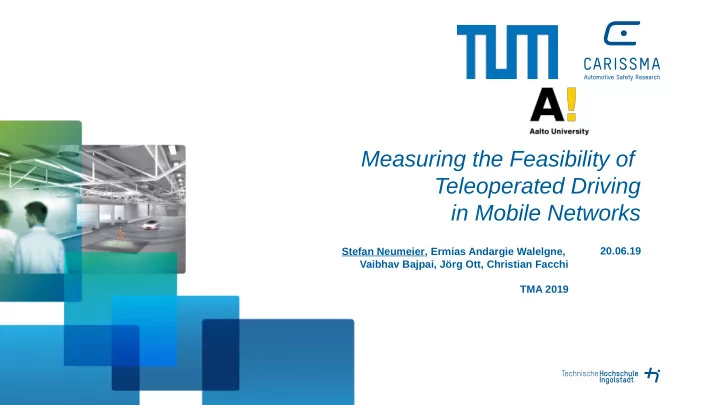

Measuring the Feasibility of Teleoperated Driving in Mobile Networks 20.06.19 Stefan Neumeier, Ermias Andargie Walelgne, Vaibhav Bajpai, Jörg Ott, Christian Facchi TMA 2019
Outline Introduction ● Requirements ● Setup ● Dataset + Results ● Conclusion ● 2/16 Measuring the Feasibility of Teleoperated Driving in Mobile Networks | TMA 2019 | Stefan Neumeier, 20.06.2019
What is Teleoperated Driving Remote control of Vehicles ● Based on: T. Tang, F. Chucholowski, and M. Lienkamp, “Teleoperated driving basics and system design,” ATZ worldwide, vol. 116, no. 2, pp. 16–19, Feb 2014. [Online]. Available: https://doi.org/10.1007/s38311-014-0018-1 3/16 Measuring the Feasibility of Teleoperated Driving in Mobile Networks | TMA 2019 | Stefan Neumeier, 20.06.2019
Why Teleoperated Driving? Vehicles may not solve all situations autonomously ● Until Level 5 (fully autonomous vehicles) – Supporting of non autonomous features – From Level 5 ● Software/Hardware failures – Exceptional situations – Use Cases ● Emergency Support – Valet Parking Service – Etc. – 4/16 Measuring the Feasibility of Teleoperated Driving in Mobile Networks | TMA 2019 | Stefan Neumeier, 20.06.2019
Challenges in Teleoperated Driving Teleoperated Driving needs Cellular Network ● Bandwidth ● Variable – Probably Low – Latency ● Variable – Probably High – Jitter ● No Connection ● -> Leads to problematic situations ● 5/16 Measuring the Feasibility of Teleoperated Driving in Mobile Networks | TMA 2019 | Stefan Neumeier, 20.06.2019
Requirements for Teleoperated Driving Downlink: ● 0.25 Mbit/s – Based on: Steering command all 10 ms – Uplink: ● Min. 3 MBit/s – Based on: Resolution 640 x 480; three 90° cameras (front: two, back: one) – Latency: ● Max. 250 ms – 300 ms tolerable latency based on user study (- Time for Sensors/Actuators of 50 ms) – Jitter max 150 ms – 6/16 Measuring the Feasibility of Teleoperated Driving in Mobile Networks | TMA 2019 | Stefan Neumeier, 20.06.2019
Measurement Setup Hardware ● Lenovo B – SierraWireless – Software ● Ping – Netradar – Smartphone measurement tool ● Iperf3 – Two setups for easy use and comparison ● Availability of test vehicle – Easiness in using – 7/16 Measuring the Feasibility of Teleoperated Driving in Mobile Networks | TMA 2019 | Stefan Neumeier, 20.06.2019
Dataset Measurement Period ● May 2017 – end of December 2017 – About 5200 km and 78 h of driving ● Ping: 2180 km – Netradar: 2670 km – SierraWireless: 354 km – Ping Netradar SierraWireless 8/16 Measuring the Feasibility of Teleoperated Driving in Mobile Networks | TMA 2019 | Stefan Neumeier, 20.06.2019
Results - Latency Ping ● Median latency of about 55.14 ms – 96 % below 250 ms – Median jitter of about 10 ms – 5 % above 150 ms – Ping Netradar ● UDP latency – Median latency of about 55 ms – 96 % below 250 ms – Median jitter of about 2 ms – 4 % above 150 ms – Netradar 9/16 Measuring the Feasibility of Teleoperated Driving in Mobile Networks | TMA 2019 | Stefan Neumeier, 20.06.2019
Results – Downlink Throughput Netradar ● TCP troughput – Median of about 17 MBit/s – 95 % above 0.25 MBit/s – Netradar Median variance of 0.15 MBit/s – SierraWireless ● Iperf3 throughput – Median of about 28 Mbit/s – 99 % above 0.25 Mbit/s – Median variance of 0.41 MBit/s – SierraWireless 10/16 Measuring the Feasibility of Teleoperated Driving in Mobile Networks | TMA 2019 | Stefan Neumeier, 20.06.2019
Results – Uplink Throughput Netradar ● Median of about 12 MBit/s – 87 % above 3 MBit/s – Median variance about 0.07 MBit/s Netradar – SierraWireless ● Median of about 18 Mbit/s – 98 % above 3 Mbit/s – Median variance about 0.07 MBit/s – SierraWireless 11/16 Measuring the Feasibility of Teleoperated Driving in Mobile Networks | TMA 2019 | Stefan Neumeier, 20.06.2019
Results – Identical Routes Latency - Ping and Netradar ● Ping: about 57 ms – Netradar: about 55 ms – → Results are roughly comparable with same Hardware Throughput – Netradar and SierraWireless ● Ping/Netradar Netradar/SierraWireless Downlink: 15 MBit/s (Netradar) ↔ 32 MBit/s (SierraWireless) – Uplink: 13 MBit/s (Netradar) ↔ 20 MBit/s (SierraWireless) – → Most likely attributed to the two antennas 12/16 Measuring the Feasibility of Teleoperated Driving in Mobile Networks | TMA 2019 | Stefan Neumeier, 20.06.2019
Results – Different Scenarios Handover ● Latency and Throughput get worse if changing cellular technology (e.g. LTE → 3G) – Median decrease to 15 % of original speed – Speed ● 0 – 150 km/h – No influence on latency or throughput – Signal-Strength ● Better Signal-Strength, higher throughput – Latency: No tendency can be seen – Distance to base station ● No influence can be seen – 13/16 Measuring the Feasibility of Teleoperated Driving in Mobile Networks | TMA 2019 | Stefan Neumeier, 20.06.2019
Results – Whitelisting as possible Approach Whitelisting: Teleoperated Driving only in areas ● that provide sufficient network performance 14/16 Measuring the Feasibility of Teleoperated Driving in Mobile Networks | TMA 2019 | Stefan Neumeier, 20.06.2019
Limitations Amount and type of measurements ● Changes in network are likely to occur ● Results reflect client‘s perspective ● Network is treated as Black-Box ● No information on how busy cells were ● → Nevertheless, results can be used to get a first impression if Teleoperated Driving could work at all with contemporary mobile networks. 15/16 Measuring the Feasibility of Teleoperated Driving in Mobile Networks | TMA 2019 | Stefan Neumeier, 20.06.2019
Conclusion Teleoperated Driving may be feasible with contemporary mobile networks ● Whitelisting can work ● However, Teleoperated Driving can not be used in all situations ● Handover can have negative influence ● Signal strength can influence throughput ● Fluctuation of latency can increase with far vehicles (e.g. more than 250 km away of operator) ● Future work has to deal with limitations, e.g. improve the whitelisting ● If you have further questions: stefan.neumeier@thi.de – 16/16 Measuring the Feasibility of Teleoperated Driving in Mobile Networks | TMA 2019 | Stefan Neumeier, 20.06.2019
Recommend
More recommend